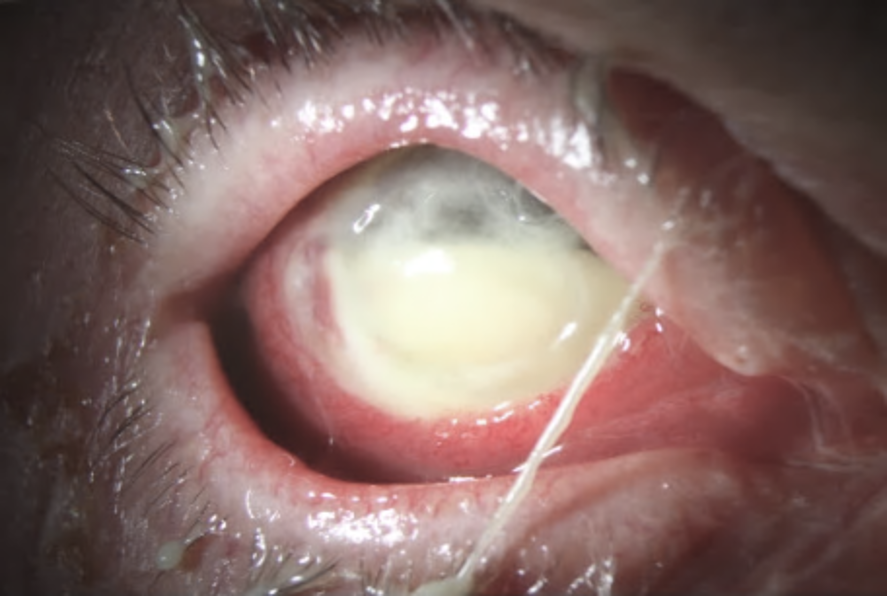
THE SOLUTION
Rose Bengal Photodynamic Antimicrobial Therapy (RB PDAT)
RB PDAT was developed at the Ophthalmic Biophysics Center of Bascom Palmer Eye Institute over more than 10 years
- Innovative therapy for acute treatment, leveraging the inherent anti-pathogenic properties of bioactive synthetic small molecule Rose Bengal (RB) and light activation
- Clinically validated by medical centers in the U.S., India, Brazil, and Mexico in hundreds of patients to date
- Non-clinical research and clinical use data published and presented in dozens of peer-reviewed journals and medical conferences by Bascom Palmer and others

Broad-Spectrum Efficacy
Active against multiple types and strains of pathogens, reducing or eliminating the likelihood of resistance

Non-Invasive Treatment
Easy to administer; avoids the need for surgery

Rapid Resolution
Faster, better treatment outcomes compared to traditional therapies

Cost Effectiveness
Lower direct and indirect treatment costs (e.g., operative and non-operative services, loss of wages)
A Steadily Worsening and Very Troubling Global Health Risk to Sight
Poor eye hygiene, environmental causative elements, limitations of and inaccessibility to standard medicines, and increasing multidrug resistance are among the risk factors that contribute to these rising numbers
5-10 million
People affected annually
by infectious keratitis, globally
100,000
Americans affected annually
by infectious karatitis
Pathogenic Sources
Bacterial, Fungal, Viral, and Parasitic


Clinically Validated Treatment:
Rose Bengal PDAT

Potentially safe, effective, durable, non-invasive, accessible, affordable therapy that can treat broad-spectrum eye infections, address multidrug resistant pathogens, achieve timely complete resolution, and avoid surgical intervention
- Topical application and illumination of bioactive synthetic small molecule rose bengal
- Demonstrated broad-spectrum activity both in vitro and in clinical use
- No significant toxicity/adverse effects in keratocytes, corneal structures, or the iris or the retina

Multi-modal mechanisms of action:
- RB-generated reactive oxygen species damages microbial cells (cell membranes, proteins, DNA) and leads to their death
- Emerging RB may induce anti-microbial peptides in eye epithelial cells upon contact, leading to pro- and anti-inflammatory modulation of innate and adaptive immune responses and signaling pathways
Simulation of RB PDAT Treatment
Global RB PDAT Clinical Data
for Infectious Keratitis

- 76% successful treatment
- Average of 184 days to clinical resolution
- Acanthamoeba, pseudomonas, fusarium
- Main risk factor: Contact lens wear

- Improved visual outcomes
- Multidrug-resistant (MDR) P aeruginosa keratitis after an artificial tear contamination outbreak
- RB PDAT has “…broad coverage and no known antibiotic resistance”

- 62% successful treatment
- Average of 45 days to clinical resolution
- Fusarium, P aeruginosa, staphylococcus epidermidis
- Main risk factors: Contact lens wear, ocular trauma, contact with soil

- 100% successful treatment of fusarium (3 patients)
- Average of 39 days to clinical resolution
- Worsened with aspergillus and acremonium (4 patients)
- Main risk factor: Contact with environment

- 73% successful treatment
- Average of 29 days to clinical resolution
- Acanthamoeba, yeast fungi, filamentous fungi, S pneumoniae, P aeruginosa
- Main risk factors: Contact lens wear, ocular trauma, contact with soil

- RB PDAT “…will improve best spectacle corrected visual acuity and also reduce complications such as corneal perforation and the need for therapeutic penetrating keratoplasty”
- Topical antimicrobial + RB PDAT vs. Top. antimicrobial + sham RB PDAT (1:1)
Purpose—To compare the in vitro effect of rose bengal and riboflavin as photosensitizing agents for photodynamic therapy (PDT) on fungal isolates that are common causes of fungal keratitis
PURPOSE: To evaluate the in vitro efficacy of rose bengal– and riboflavin-mediated photodynamic therapy for inhibition of methicillin-resistant Staphylococcus aureus (MRSA) isolates.
Purpose—To evaluate the efficacy of rose bengal photodynamic antimicrobial therapy (PDAT) for the management of a patient with multidrug-resistant Fusarium keratoplasticum keratitis unresponsive to standard clinical treatment.
In short, the case detailed a 56-year-old female patient with history of penetrating keratoplasty due to keratoconus, who presented with corneal infection secondary to Fusarium keratoplasticum, unresponsive to standard medical treatment.
Purpose—To report clinical outcomes of Rose Bengal Photodynamic Antimicrobial Therapy (RB-PDAT) as an adjunct treatment for severe, progressive infectious keratitis.
The current study suggests that even though penetration of the RB dye has been shown to be limited, oxidative stress produced by RB-PDAT can reach deeper into the corneal stroma. Nevertheless, our results show that performing RB-PDAT is safe on the corneal endothelium and has no effect on LSC viability or function.
Purpose: To evaluate the in vitro efficacy of rose bengal and riboflavin photodynamic antimicrobial therapy for inhibition the growth of four Pseudomonas aeruginosa (P. aeruginosa) isolates.
Purpose: To evaluate in vivo corneal changes after Rose Bengal photodynamic antimicrobial therapy treatment (RB-PDAT) in New Zealand White (NZW) rabbits.
A 68-year-old Hispanic male with history of sleeping with soft contact-lens presented with a severe corneal ulcer in the left eye. His visual acuity was HM. Examination revealed limbus to limbus corneal infiltration with active melting and a 30% hypopyon (A).
In ophthalmology, photodynamic therapy (PDT) has been used for numerous applications. PDT with Rose Bengal as a photosensitizer combined with green light optical irradiation (RB-PDAT) is a novel treatment with dual purpose: to arrest the infection from progressing and strengthen the collagen of the cornea.
Purpose: To examine and compare the efficacy of in vitro growth inhibition using rose bengal and riboflavin photodynamic antimicrobial therapy (PDAT) for Nocardia keratitis isolates.
PURPOSE: To evaluate the intermediate-term clinical outcomes of Rose Bengal Photodynamic Antimicrobial Therapy (RB-PDAT) for infectious keratitis; secondarily, to evaluate the surgical outcomes of individuals who underwent optical keratoplasty after RB-PDAT.
The purpose is to assess the efcacy of rose bengal photodynamic antimicrobial therapy (PDAT) using diferent irradiation energy levels and photosensitizer concentrations for the inhibition of fungal keratitis isolates.
OBJECTIVE: To document the disease progression of carbapenemase-resistant P aeruginosa keratitis after an artificial tear contamination outbreak.
Aim: Rose Bengal photodynamic antimicrobial therapy (RB-PDAT) has poor corneal penetration, limiting its efficacy against acanthamoeba keratitis(AK). Iontophoresis enhances corneal permeation of charged molecules, piquing interest in its effects on RB in ex vivo human corneas.
Purpose: To report a successfully managed case of idiopathic Fusarium sclerouveitis in a healthy patient with no identifiable risk factors.
Treatment shows potential as a valuable adjunct therapy to treat corneal infections
Purpose To report the utility of Rose Bengal Photodynamic Antimicrobial Therapy (RBPDAT) as an adjunct treatment in rapidly progressing Infectious Necrotizing Scleritis (INS) secondary to Pseudomonas aeruginosa. Methods Retrospective chart review was conducted on consecutive patients with scleritis and culture-proven Pseudomonas aeruginosa who underwent RB-PDAT. energy levels and photosensitizer concentrations for the inhibition of fungal keratitis isolates.
Purpose: Fungal keratitis has a poor prognosis given deep penetration into the corneal stroma. While Rose Bengal photodynamic antimicrobial therapy (RB-PDAT) is a promising adjunct treatment for refractory cases, poor penetration limits its effectiveness. This study explores the penetration depth of alternative photosensitizers to address this issue.
Background/Purpose: To compare the microbiologic and histopathologic features of Acanthamoeba isolates recovered from patients with Acanthamoeba keratitis (AK) who underwent a therapeutic penetrating keratoplasty (TPK), optical penetrating keratoplasty (OPK), or deep anterior lamellar keratoplasty (DALK) after Rose Bengal Photodynamic Antimicrobial Therapy (RB-PDAT).
Other Institutions
Purpose: To report the clinical outcome of Photodynamic Antimicrobial Therapy (PDAT) with Rose Bengal (RB) used as an early adjuvant therapy in patients with fungal keratitis and their microbiological and pathological correlation.
Fungal or acanthamoeba keratitis often has a poor outcome despite receiving the best available medical therapy. Rose Bengal Photodynamic Therapy (RB-PDT) may directly kill infectious organisms and strengthen the cornea, reducing the risk of perforation or need for therapeutic penetrating keratoplasty. This protocol describes the first large, NIH-funded, randomized clinical trial to study this therapy in patients and will determine whether RB-PDT is a beneficial adjunctive therapy for infectious keratitis.
Purpose: To report the outcome of Acanthamoeba keratitis, with early addition of Photo-dynamic antimicrobial therapy with Rose Bengal (PDAT-RB) to the medical treatment (combination of 0.02% Polyhexamethylene Biguanide (PH)and 0.02% chlorhexidine(CH)).
Abstract: Infectious keratitis (IK), including bacterial, fungal, parasitic, and viral etiologies, continues to represent a significant cause of ocular morbidity in the United States and around the world.
Objective: To determine the effect of adjunctive rose-bengal photodynamic therapy (RB-PDT) in the treatment of fungal, Acanthamoeba, and smear/culture negative infectious keratitis.
Purpose: To describe the use of Rose Bengal Photodynamic Antimicrobial Therapy (RB-PDAT) combined with amniotic membrane graft (AMG) as a novel surgical technique for infectious keratitis in a patient with Boston Keratoprosthesis (B-Kpro) type 1 Lucia.
Abstract: Candida albicans is a significant pathogen in various fungal infections, including oral candidiasis and denture stomatitis.
Objective: To determine the effect of adjunctive rose-bengal photodynamic therapy (RB-PDT) in the treatment of fungal, Acanthamoeba, and smear/culture negative infectious keratitis.
